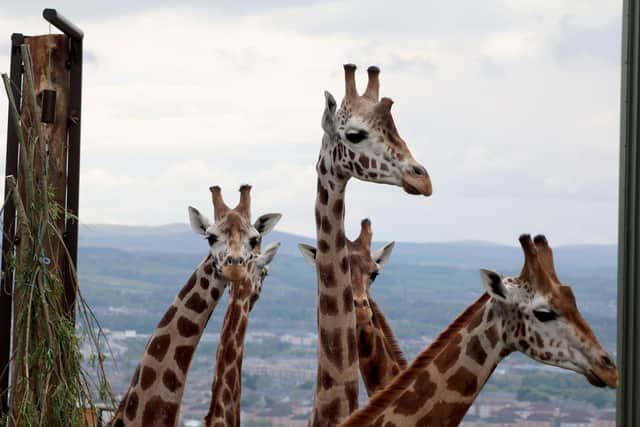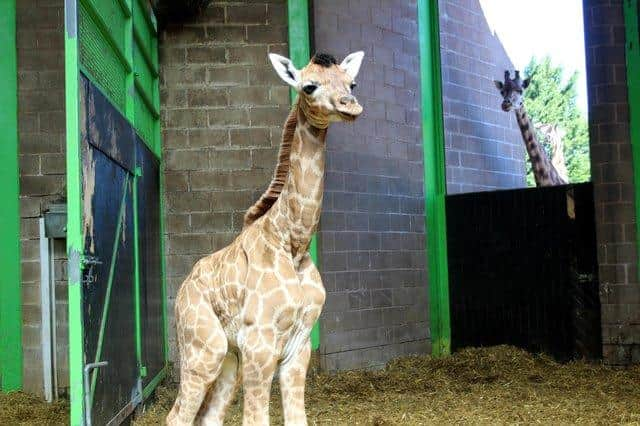Edinburgh Zoo's giraffes stretch their legs and necks as they go on show to the public for the first time
Let us know what you think and join the conversation at the bottom of this article.
Five male Baringo giraffes arrived at the RZSS attraction last month as part of a partnership with the Namibia-based Giraffe Conservation Foundation (GCF) and Glenmorangie Single Malt Scotch Whisky.
The partnership will help to educate visitors about the animals and help save them in the wild by funding vital conservation work in Africa.


Advertisement
Hide AdAdvertisement
Hide AdSince giraffes were last seen at the Zoo around 2004, the wild population has declined by more than 40% and there are now thought to be only around 117,000 left.
Giraffes Ronnie, Arrow, Fennessey, Gerald and Gilbert will help to educate the public about the animals' plight.
They will live in a new £2.8 million, state of the art house including high level walkways to allow visitors to meet them face-to-face. The animals also have an outdoor enclosure the size of a football pitch enjoying some of the best views in the city.
Darren McGarry, Head of Living Collections, said: "It's been a long time coming, through planning and construction, working together with our partners and donors to the huge task of organising the transport of five giraffes to Edinburgh and helping them to settle into their new home.


"They've settled really well and we are now delighted to be able to open up to the public. It's been over 15 years since we last had giraffes and people have longed for their return.
"There's been a lot of excitement. We've got certain areas where we can engage the visitors with the giraffes, and people love to get up close to them. I think they'll be a big favourite among all our visitors."
Edinburgh Zoo was home to giraffes from the 1930s, but the animals have been absent since 2004 due to a lack of an appropriate sized enclosure to care for them.
Advertisement
Hide AdAdvertisement
Hide AdGCF, the leading international charity dedicated to giraffe conservation and management in the wild, has warned the animals are suffering a "silent extinction".
The new arrivals are Baringo - also known as Rothschild's giraffes - a type of Nubian giraffe found in Kenya and Uganda. There are thought to be only around 3650 Nubian giraffes left in the wild, including around 1500 Baringo -- one of the most endangered distinct populations.
The animals are only around four years old and will not reach sexual maturity for around three more years. They could then be joined by females, so that the zoo can contribute to the European breeding programme for the species.
There are already family connections forming, however. Gilbert, the most recent giraffe to join the herd, is the grandson of the last giraffe to live at the Zoo 17 years ago, called Siger.
Mr McGarry, who started at the Zoo as a trainee keeper in 1986, said: "I looked after Gilbert's great grandparents, who were called Niger and Rebecca, and when they had a son we called him Siger -- the son of Niger.
"Siger was the last male giraffe that we had in the Zoo, before he was transferred to Givskud Zoo in Denmark where he was mated with a female called Ulla. They had a daughter called Daisy, who gave birth to Gilbert in Belfast five years ago."
He added: "Gilbert has a long line of relations that go back to the first giraffes I ever worked with at the zoo so we're actually bringing this family back to Edinburgh.
Advertisement
Hide AdAdvertisement
Hide Ad"All of the boys have a link through a male that we had in Edinburgh called Big Ed, and a female called Jade. Their offspring went on to produce giraffes that have produced these young males."
The Zoo received some criticism following the animals' arrival. Dr Mark Jones, head of policy for the Born Free Foundation, said: "In the 21st century, with modern technology, we can learn about and increase support for the conservation of this majestic species in the wild without needing to get up close and personal to these animals in inappropriate zoo enclosures, with all the detrimental effects that has on each individual animal’s health and welfare."
But Mr McGarry said : "This is pure conservation in action. I think the giraffes will be very happy here."
A message from the Editor:
Thank you for reading this article. We're more reliant on your support than ever as the shift in consumer habits brought about by coronavirus impacts our advertisers.
If you haven't already, please consider supporting our trusted, fact-checked journalism by taking out a digital subscription.
Comments
Want to join the conversation? Please or to comment on this article.